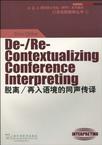脱离/再入语境的同声传译
2010-2
上海外语教育出版社
Ebru Diriker
221
无
本书分析了社会、文化与口译互动方面的学术活动和科研状况,指出迄今为止相关课题的学术研究成果多囿于认知学和心理语言学的范畴,很少有人将会议口译当作设于语境中的行动来研究。作者从社会和文化的角度出发,将口译员设在会议语境中,考察了社会和文化语境与口译员在会场的存在及其口译表现之间的动态关系。作者通过亲身观察、采访相关人员以及对会议的文字记录进行分析,澄清了坊问流传的对会议口译的误解。作者也同时指出,在具体语境中研究会议口译的工作任重而道远。
爱布茹·迪利克(Ebru Diriker)任教于土耳其海峡大学翻译学院。
AcknowledgmentsIntroductionCHAPTER 1 Previous Hterature,key concepts and grounding theories 1.1 Simultaneous Interpreting Research 1.2 Previous research on actual SI behavior in relation to socio—cultural and interactional contexts 1.3 Context 1.4 DiSCOurse 1.5 Basic theoretical assumptions on“discourse”CHAPTER 2 Broader social context in SI 2.1 Meta—discourse as social context 2.2 Meta—discourse on SI 2.2.1 Discourse of general reference books 2.2.2 Discourse of codes of ethics 2.2.3 Discourse of professional organizations 2.2.4 Discourse of academia 2.2.5 Discourse of Turkish media 2.2.6 Discourse of interpreters in the media 2.2.7 Discourse of a popular book 2.3 Summary 48CHAPTER 3 Analyzing an actual conference context 3.1 Constructing the COrpus:General reflections 3.2 Constructing the COrpUS in this study 3.2.1 Topic,date and venue of the conference 3.2.2 Conference languages 3.2.3 Interpreters,organizer and the recruitment process 3.2.4 Permission to record 3.2.5 Technical matters 3.2.6 Position of the booths 3.2.7 My position as the researcher 3.2.8 Participants 3.2.9 Speakers 3.2.10 Preparations,documents and the“assistant’’in the booth 3.2.1 1 Turn—taking 3.3 Interviews 3.3.1 Interview with the organizer 3.3.2 Interviews with the speakers 3.3.3 InterviEWS with the interpreters 3.3.4 Interviews wi出the users of SICHAPTER 4 Analyzing an actual SI performance 4.1 Constructing the transcripts in this study 4.2 Deciding on a unit of analysis 4.3 Exploring the“shifts in the speaking subject” 4.4 Presenting the analysis 4.5 Analyzing the conference transcripts 4.5.1 “Shifts in the speaking subject’’in the present corpus 4.5.2 Last 25 minutes of the conference interactionCHAIRIER 5 Juxta.and counterposing actual SI behavior with the meta_discourse 5.1 Juxtaposing actual SI behavior with the meta—discourse 5.1.1 Broader socio—cultural context:What the meta—discourse suggests 5.1.2 Presence of interpreters:What participant observations and interviews sug-gest 5.1.3 Performance of interpreters:What conference transcripts suggest 5.2 Counterposing actual SI behavior with the meta—discourse 5.2.1 Implications for SI researchFinal remarksAppendix Transcription convention “Shifts in the speaking subject”in the delivery in their order of occurrence during the conferenceNotesReferencesIndex
According to Bour dieu, the production of linguistic utterances or expressions always occurs in particular contexts or "market s".s The properties of the second texts or markets bestow a certain "value" on particular discourses. While producing linguistic expressions, speakers take into account —— in varying way sand to different extents——the market conditions within which their products will be received and valued by others. They assess the market conditions, and anticipate the likely reception of their linguistic products with the ultimate objective of maximizing their access to various forms of capital which can beeconomic, cultural and social. Thus, speakers implicitly and routinely modifytheir expressions in anticipation of their likely reception, which implies that alldiscourses are to some extent "euphemized", i.e., they are modified by a certain kind of censorship which stems from the structure of the market but which is transformed into self-censorship through the process of anticipation (ibid.:19).Discourse naturalizes and creates "myths"- The use of discourse in enhancing diffeent forms of capital results in the constitution of, what Bourdieu (ibid.) calls,"legitimate language". While "legitimate language" shapes and takes shape inrelation to social, historical, ideological, cultural and market conditions, it develops a certain repertoire which involves and further reinforces aspects that grantlanguage its "legitimacy" and "authority". This repertoire is not static in nature,on the contrary, there is always a constant struggle between those who want to maintain it and those who want to change it. Thus, it is never complete and final.However, when analyzing in synoptic shots, one can see certain features which look so natural and authoritative that they appear to be the sole and most correct forms of language and language use possible. The authoritativeness and naturalness with which any meta-discourse represents its object is linked with the process of "myth-making" in discourse. According to Barthes (1992), all meta-language (i.e., language about an object) tends to naturalize and rationalize the historicity and complexity of the object it represents. Everything can become a myth in language if there is an ideologicalneed for it in human history. Thus, the naturalization and rationalization of theobject in meta-language always serves a purpose or necessity. Being features of meta-language, myths always operate by tearing the actualobject from its situationality and historicity. Thus, myths always work on decontextualized objects and give these objects a "blissful clarity".

无